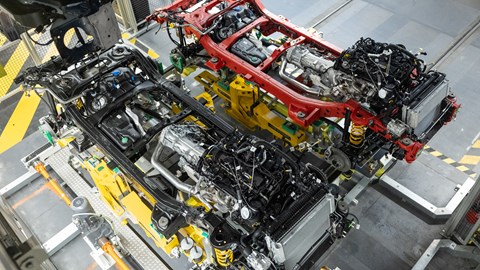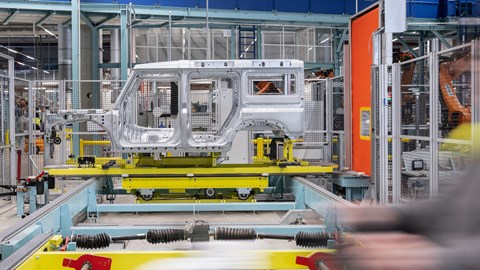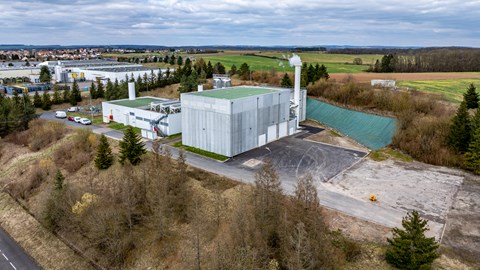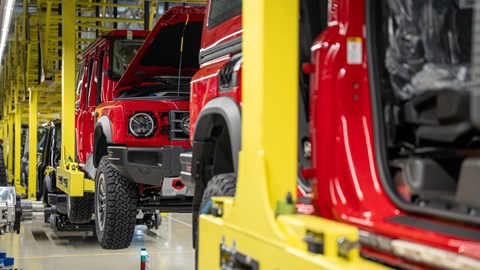► CEO critical of EU attitude to tariffs
► Calls for clarity on electrification
► Cleans up factory with biomass investment
Its cars may be highly traditional, but the way Ineos Automotive operates doesn’t conform to the habits of longer-established car makers. Outspoken CEO Lynn Calder isn’t afraid to call out politicians for their flip-flopping on electrification and is critical of other car makers for trying to railroad customers into cars they don’t want. And now she’s hit out at the EU’s response to US President Donald Trump’s plans for import tariffs.
The company, owned by petrochemicals billionaire Jim Ratcliffe, said in a statement: ‘We are outraged that the tariff situation with the US has been neglected by the EU. President Trump has been very clear on his intention to implement tariffs on the auto industry. He has been asking for fairness and reciprocity and yet European leaders have not come to the table to negotiate a better solution.

‘The US government has also been clear about the consequences of non-engagement. This should be a surprise to no one in the EU, and it could and should have been averted.’
Cars built in the EU and sold in the US will be hit with a 25 per cent tariff, due to start on 2 April. The Ineos Grenadier 4×4 and Quartermaster pick-up are built at Hambach in France, a former Mercedes factory.
Calder added: ‘This is what happens when politicians sit on their hands. As a growing EU-based automobile brand, we are vulnerable to tariffs, and we need our politicians to support our business, our jobs and our economies. We need urgent and direct political intervention on tariffs.
‘We will give whatever support we can to our political leaders to keep the playing field even for small, competitive brands such as Grenadier. But we must see action from EU politicians: only they are in a position to address the issue. Fortunately, we have been planning for tariffs but there is only so much we can do to protect US customers from price rises.’

Half its sales last year were in the US, and Ineos has high hopes of significantly increasing that in 2025 as it opens more retailers across the nation. It’s now in more than 50 countries, with Mexico and China among them, so its eggs are in many baskets, but the US is too big a deal in the off-road world to surrender lightly.
She’s also unhappy with the EU, and various other politicians, for their lack of clarity and consistency on ways to reduce harmful emissions.
Having revealed the look of the Fusilier – a smaller, more modern-looking 4×4, with a choice of electric or range-extender powertrain – last year, Ineos has now put that on the back burner.
‘There are some discussions going on in the EU about what exactly will be banned. We don’t want to spend any more money until we know what the landscape looks like.

I’m hopeful. But at the moment we’re going to concentrate on the platform that we’ve actually built. There’s so much we can do with that.’
The Grenadier, currently offered only with non-electrified diesel and petrol sixes, will in a couple of years evolve to mild-hybrid powertrains from BMW. But the long-term future is unclear, with sales of new hybrids as well as pure-combustion cars currently set to be banned within a decade.
‘If we can’t get that clarity, then we’ve got other markets. I don’t want that to be the case. UK, Germany, France, Austria – these are our heartland countries for a British company with Austrian and German engineering and components, manufactured in France – how sad to be not be bringing our cars into those markets. That’s not the plan. But we would really like governments to recognise that what they might like ideologically is not happening. Tell us where you want to get to from a future emissions reduction perspective and let us – the whole industry – come with a menu of options to get to that CO2 level.’

She added: ‘My other complaint is that they just seem to think they can make these decisions at the last minute and the automotive industry can just click their fingers. As agile as we’ve said we are, it doesn’t really work that way.’
In a jibe at other car makers, who were having to reintroduce combustion engines to meet demand from EV-averse buyers, she said: ‘What we’re seeing at the moment is what happens when you forget that if people don’t want something you can’t force it on them.’
Two years ago, Ineos showed a prototype hydrogen fuel cell version of the Grenadier, but that has also been put on pause, as the number of hydrogen filling opportunities in the UK and elsewhere has started to reduce. Although the Ineos group of companies is involved in hydrogen, Ineos Automotive can’t currently see it becoming an option for car drivers.
For all her frustration with politicians, Calder remains committed to net zero as a target. That’s why Ineos has invested €15m in a biomass plant at the Hambach factory. It will take care of 78 per cent of the giant plant’s heating, and in so doing reduce the CO2 emissions by 8800 tonnes.It uses local woodchips – up to 14,000 tonnes a year, sustainably sourced. The chips are burnt in two boilers, connected to a heat pump. Waste ash, with a high nitrate content, will be used as fertilisers by local farmers.